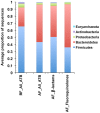Short-term effect of antibiotics on human gut microbiota
- PMID: 24748167
- PMCID: PMC3991704
- DOI: 10.1371/journal.pone.0095476
Short-term effect of antibiotics on human gut microbiota
Abstract
From birth onwards, the human gut microbiota rapidly increases in diversity and reaches an adult-like stage at three years of age. After this age, the composition may fluctuate in response to external factors such as antibiotics. Previous studies have shown that resilience is not complete months after cessation of the antibiotic intake. However, little is known about the short-term effects of antibiotic intake on the gut microbial community. Here we examined the load and composition of the fecal microbiota immediately after treatment in 21 patients, who received broad-spectrum antibiotics such as fluoroquinolones and β-lactams. A fecal sample was collected from all participants before treatment and one week after for microbial load and community composition analyses by quantitative PCR and pyrosequencing of the 16S rRNA gene, respectively. Fluoroquinolones and β-lactams significantly decreased microbial diversity by 25% and reduced the core phylogenetic microbiota from 29 to 12 taxa. However, at the phylum level, these antibiotics increased the Bacteroidetes/Firmicutes ratio (p = 0.0007, FDR = 0.002). At the species level, our findings unexpectedly revealed that both antibiotic types increased the proportion of several unknown taxa belonging to the Bacteroides genus, a Gram-negative group of bacteria (p = 0.0003, FDR<0.016). Furthermore, the average microbial load was affected by the treatment. Indeed, the β-lactams increased it significantly by two-fold (p = 0.04). The maintenance of or possible increase detected in microbial load and the selection of Gram-negative over Gram-positive bacteria breaks the idea generally held about the effect of broad-spectrum antibiotics on gut microbiota.
Conflict of interest statement
Figures



Similar articles
-
The altered gut microbiota in adults with cystic fibrosis.BMC Microbiol. 2017 Mar 9;17(1):58. doi: 10.1186/s12866-017-0968-8. BMC Microbiol. 2017. PMID: 28279152 Free PMC article.
-
Gut microbiota disturbance during antibiotic therapy: a multi-omic approach.Gut. 2013 Nov;62(11):1591-601. doi: 10.1136/gutjnl-2012-303184. Epub 2012 Dec 12. Gut. 2013. PMID: 23236009 Free PMC article.
-
Comparative gut microbiota and resistome profiling of intensive care patients receiving selective digestive tract decontamination and healthy subjects.Microbiome. 2017 Aug 14;5(1):88. doi: 10.1186/s40168-017-0309-z. Microbiome. 2017. PMID: 28803549 Free PMC article.
-
Defining the human microbiome.Nutr Rev. 2012 Aug;70 Suppl 1(Suppl 1):S38-44. doi: 10.1111/j.1753-4887.2012.00493.x. Nutr Rev. 2012. PMID: 22861806 Free PMC article. Review.
-
Antibiotics and the gut microbiota.J Clin Invest. 2014 Oct;124(10):4212-8. doi: 10.1172/JCI72333. Epub 2014 Oct 1. J Clin Invest. 2014. PMID: 25271726 Free PMC article. Review.
Cited by
-
Network pharmacology and in vivo and in vitro experiments to determine the mechanism behind the effects of Jiawei Yanghe decoction via TLR4/Myd88/NF-κB against mastitis.Heliyon. 2023 Oct 21;9(11):e21219. doi: 10.1016/j.heliyon.2023.e21219. eCollection 2023 Nov. Heliyon. 2023. PMID: 37964842 Free PMC article.
-
Our Evolving Understanding of Kawasaki Disease Pathogenesis: Role of the Gut Microbiota.Front Immunol. 2020 Jul 24;11:1616. doi: 10.3389/fimmu.2020.01616. eCollection 2020. Front Immunol. 2020. PMID: 32793240 Free PMC article. Review.
-
Effects of Varied Sulfamethazine Dosage and Exposure Durations on Offspring Mice.Microorganisms. 2024 Feb 13;12(2):381. doi: 10.3390/microorganisms12020381. Microorganisms. 2024. PMID: 38399785 Free PMC article.
-
Different Dynamic Patterns of β-Lactams, Quinolones, Glycopeptides and Macrolides on Mouse Gut Microbial Diversity.PLoS One. 2015 May 13;10(5):e0126712. doi: 10.1371/journal.pone.0126712. eCollection 2015. PLoS One. 2015. PMID: 25970622 Free PMC article.
-
May the Force Be With You: The Light and Dark Sides of the Microbiota-Gut-Brain Axis in Neuropsychiatry.CNS Drugs. 2016 Nov;30(11):1019-1041. doi: 10.1007/s40263-016-0370-3. CNS Drugs. 2016. PMID: 27417321 Free PMC article. Review.
References
-
- McNulty CA (2012) European Antibiotic Awareness Day 2012: general practitioners encouraged to TARGET antibiotics through guidance, education and tools. J Antimicrob Chemother 67: 2543–2546. - PubMed
Publication types
MeSH terms
Substances
LinkOut - more resources
Full Text Sources
Other Literature Sources
Medical

